ASUS P9X79-E WS Review: Xeon meets PLX for 7x
by Ian Cutress on January 10, 2014 10:00 AM EST- Posted in
- Motherboards
- Asus
- Workstation
- X79
- Prosumer
ASUS P9X79-E WS Conclusion
As mentioned in the outset of the review, workstation motherboards have not had much attention on AnandTech of late. They aim at a market almost more straightforward than the consumer market – they have to do a job, do it well, and remain stable. This is why Xeon processors and ECC memory compatibility are paramount, to go along with the extended or business oriented warranties and to be able to power mission critical systems without failure.
The market for prosumer level motherboards is a difficult one to gauge, especially in terms of numbers. ASUS have had WS models for several generations, and their competitors are certainly viewing it as a market with consistent sales – as a business customer the need for something that is powerful and stable is a path on the road to success.
ASUS have taken the standard P9X79 WS and essentially pimped it out with more of everything, as well as updating the package specifically of Intel’s Ivy Bridge-E consumer processors and Xeons. It does support ECC memory, albeit up to 64 GB is listed though it would be interesting to see 16GB ECC modules in place. One of the key features for the P9X79-E WS, and the ASUS WS range, is the level of validation testing of PCIe devices (RAID cards, GPUs, GPGPUs, sound cards, storage, and so on): while a consumer level product might have issues with a particular card, ASUS aim to make the WS series support it.
One of the main draws of the P9X79-E WS will be the numerate PCIe slots. Due to the use of PLX PCIe switches on board, these slots are wired for x16/x16/x16/x16 up to x16/x8/x8/x8/x16/x8/x8, and will accept Xeon Phi processing boards with the relevant BIOS switch activated. ASUS have only placed one 6-pin PCIe VGA power connector on board, which may not be enough for a potential total 525W power draw through these 7 slots (75W per slot). In order to help diagnose this, the Dr. Power circuitry added on board (with software in Windows) is designed to help should the power supply or motherboard be pushed for power draw.
Other functionality includes 12 SATA ports (6 PCH, 4 SATA 6 Gbps via Marvell, 2 eSATA), with the Marvell ports suitable for SSD Caching – whether SSD caching is suitable for 2014 is another matter. ASUS could have used the Intel C606 chipset to add SAS/SATA ports instead, but went down the X79+Marvell route. Despite no native USB 3.0 on X79, there are two USB 3.0 ports on the rear IO and a header on board. Alongside dual Intel I210 NICs we also get the Realtek ALC1150 audio codec, the high end audio codec from Realtek.
Due to the P9X79-E WS implementing MultiCore Turbo, our consumer CPU saw 4.0 GHz on any load, which allowed the P9X79-E WS to hit the top of the charts in many of our benchmarks, like other X79 motherboards that also enable MultiCore Turbo properly. Despite the focus on workstations, Xeons and ECC, there are minor overclock options which set our consumer overclockable CPU to 4.5 GHz with just a flick of a switch.
The BIOS is updated to the new ‘Z87’ generation, using features such as My Favorites, Quick Note and Last Modified as well as a fixed length font to aid user readability. The fan headers on board are designed to be controlled via the BIOS and the OS, with the OS software wrapped up in the X79/Z77 generation of AI Suite. This still includes features like Fan Xpert, USB 3.0 Boost, TurboV Evo, EPU, AI Charger and SSD Caching as mentioned before.
One issue I came across was that USB 3.0 Boost needed updating from the version on the CD (Turbo mode would not disable), and the other is the extended heatsink arrangement – due to the number of extra controllers and PCIe switches used onboard, the heatsink did heat up to be uncomfortable to touch. After speaking with ASUS, it was clear that they recommended a high airflow environment for workstation model products. The P9X79-E WS does come with a 3 year warranty and ASUS Premium Service for North America users.
The P9X79-E WS fits in that high end, prosumer niche. It is perhaps missing some features the high end performance needs (Thunderbolt, native USB 3.0), but that should be at the feet of Intel not updating X79 rather than ASUS. When a user is spending $560 to $3000 on a CPU (4930K or E5-26xx v2), then the motherboard becomes less of a % of the build overall and thus moving to a high end product is less of an overall percentage hit. This is the market ASUS is going for, and the P9X79-E WS goes well for the prosumer that needs as many PCIe slots with all the PCIe lanes as a motherboard can carry.












53 Comments
View All Comments
Hammerfist - Friday, January 10, 2014 - link
What are the effects of PLX chip when using two or more R9 290 in crossfire ?We know that when doing AFR , R9 290 and R9 290X uses the PCIe lanes to move the frame around from on GPU to another .
A frame time testing with two GPUs in different lanes will be very interesting .
PCIe 1 - PCIe 2 -> Goes through the PLX chip and QS
PCIe 2 - PCIe 3 -> Goes through QS only
PCIe 1 - PCIe 5 -> Goes through both PLX chips
PCIe 2 - PCIe 6 -> Goes through both PLX and QS chips
and possibly more combinations.
I am not saying that all possible combinations need to be tested , just two combinations to give us and idea of the latency involved is good enough like
1) PCIe1 - PCIe3 (only PLX)
2) PCIe2 - PCIe6 (both PLX and QS)
Ian Cutress - Saturday, January 11, 2014 - link
I did some PLX testing on various Z87 motherboards that use one of the chips, and the overall defecit over ideal routing was a 1-2% loss per PLX chip in the worst case scenario. This is better than the old NF200s, which had up to a 5-10% loss iirc? Of course with X79 it's a little different in that the CPU could go for an x16/x8/x8/x8 layout and whether going for an x16/x16/x16/x16 would make a difference. While I don't have 290 cards to hand, I do have 7970s and now GTX 770s to do a small comparison in the future.watersb - Saturday, January 11, 2014 - link
Ian, thanks very much for this review.I am not a gamer, but my science and storage workloads are well met by Xeon workstations. The build-your-own route can make financial sense sometimes, depends on the job.
Glad you are there checking it all out.
mapesdhs - Saturday, January 11, 2014 - link
The main benefit of a DIY oc build is gaining access to the performance equivalent to anexpensive high-core XEON on a lower budget. XEONs with lots of cores have much lower
clocks, so a 6-core SB-E or IB-E at 4.7+ runs very well. There are tradeoffs of course,
such as non-ECC RAM being used; this might rule out the idea for some tasks. Still, there's
a lot of scope for building something fast without breaking the bank. If one needs a degree
of reliability though then I guess just step back a step or two on the oc, say 4.5GHz, and/or
go for top-end cooling by default such as an H110 + suitable case.
Ian.
Pooyan - Saturday, January 11, 2014 - link
Great article, Ian. Although I wish you focused more on workstation aspects of the motherboard, not gamin and stuff :D1. Do you know any motherboards from other manufacturers with similar specs?
2. ASUS says it's a CEB motherboard. So the case has to be CEB as well? Or can it be E-ATX? Isn't that kinda small for it?
Thanks again for the review.
mapesdhs - Saturday, January 11, 2014 - link
The only other board I could find that came close in overall concept to ASUS' X79 WSseries is Asrock's X79 Extreme 11. However, apart from being quite a bit more expensive,
in the end I felt Asrock messed up a bit by not using a SAS controller with any onboard
cache, which can spoil 4K performance. Given the board cost, I can't imagine why the
didn't choose an equivalent LSI chip that had a 1GB cache or something, would have
been much better. Maybe the added cost was just too much.
Can't remember offhand about CEB vs. EATX; I think CEB means the board can be
deeper aswell as longer. Either way, fits fine in a HAF 932, though the case I'd
recommend atm is an Aercool X-Predator. Caveat: if one has to move a system
around a lot, eg. transport to company sites, then choose a different case that has
handles. Either way, for max expandability, use a 10-slot case.
Ian.
Pooyan - Tuesday, January 14, 2014 - link
I thought it only fits in a CEB case. That's why I was gonna get a Silverstone RV03, because that's the only CEB I could find. This is a great help for me. It means I have other options for the case. Thanks a lot!mapesdhs - Tuesday, June 7, 2016 - link
An old thread I know, but a minor update for anyone who finds this for some reason as I recently built an editing setup with a P9X79-E WS I managed to get for only 200 quid (fitted with an i7 3970X, Quadro 6000, GTX 580 3GB, etc.): now I'm using a Corsair C70 Military Green case, definitely better. More rear slots than the HAF 932, though I'm only using two NDS fans with the H110 (decided after several builds that four is unnecessary). The C70 has fewer front 5.25" bays than the 932, but using more SSDs, etc. has meant that's not an issue.Hoping to see if it's possible to boot from a 950 Pro soon...
Ian.
Umbongo - Saturday, January 11, 2014 - link
"Being a Workstation board, the P9X79-E WS is designed to accept any socket 2011 Xeon, as well as ECC memory – up to 64GB is listed on the specification sheet, although 16GB ECC DRAM modules are now available through Newegg for $210 each."The X79 chipset supports unbuffered ECC with a Xeon. 16GB DIMMs are not available as ECC unbuffered, only ECC registered. You need a C600 series chipset with a Xeon to use registered memory.
Ian Cutress - Saturday, January 11, 2014 - link
Ah, I thought I had seen 16GB unregistered memory. Seems like I was mistaken (!)